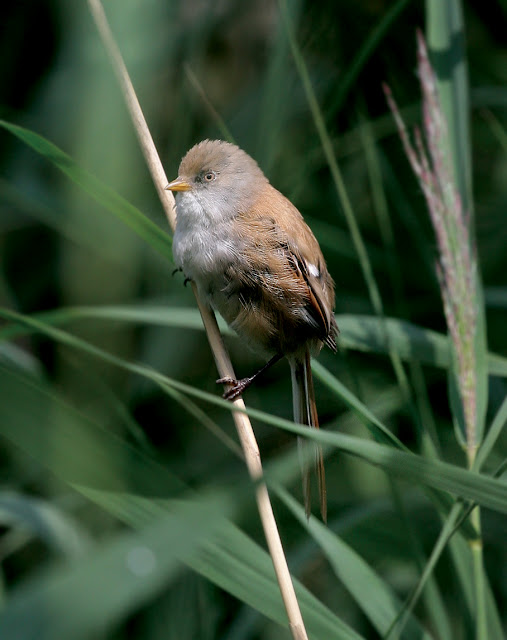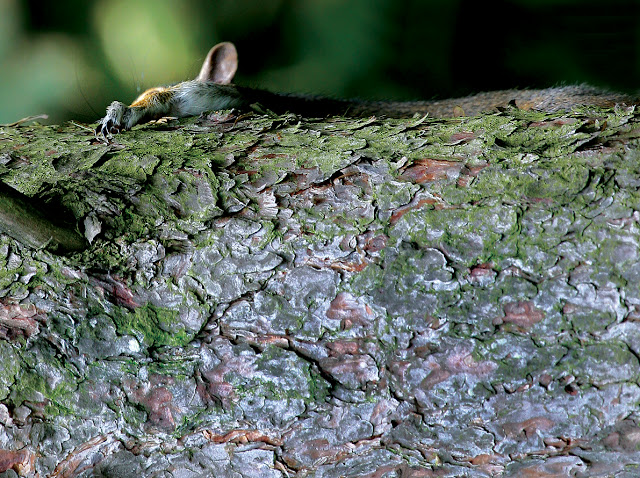 |
| Canon 1Ds Mk II, Canon 100-400mm IS USM lens, 1/1,000th sec, f/5.6, 400mm at ISO 800 |
20110816
Harvest Mouse (Micromys minutus)
Labels:
Harvest Mouse (Micromys minutus)
I have said before that I much prefer to photograph animals in their natural habitats. The images are better and the knowledge built up on the subject in question will be so much greater thanks to studying them in the wild. There is, however, not always the time available to wait for hours on the off chance of being in the right place at the right time to capture something highly elusive. This is why I took the opportunity to photograph this captive Harvest Mouse. Shooting it wasn't easy, the aim being to capture a scene with at least some semblance of realism. I will go again and if I manage to get some shots of this most adorable mammal using that famous prehensile tail, then I will post them here – if only to quote again what must be the most apt Latin name in zoology.
Blue Tit (Cyanistes caeruleus)
Labels:
Blue Tit (Cyanistes caeruleus)
20110815
The changing season
20110814
Still Life (Fox)
The moment I stumbled on this partially decomposed skeleton of a juvenile Fox (Vulpes vulpes) I believed it would make a compelling still life. The skeleton had, it appeared, remained pretty much undisturbed. Hidden beneath a pile of pallets, the animal – which appeared to have been shot (there were two holes near its heart consistent with a .22 rifle) – was positioned as it would have fallen or as it would have lay down to await its demise. The only exception was the fox's right hind leg, which had become separated. The detail remaining in the corpse was incredible. Much of the animal's skin remained over its ribcage; every one of the teeth remained in place; and the thick, pitted skin of the animal's nose was perfectly preserved. The image is, inevitably, a little macabre but – with death an inevitable part of life – I believe it is no less beautiful for that.
20110810
A touch of the exotic
Two of the more exotic individuals to be found at Pensthorpe – the Scarlet Ibis (Eudocimus ruber) and the European Bald-headed Ibis (Geronticus eremita), one of the world's most endangered birds. Though of course related, they are very different-looking birds, given a very different photographic treatment. The first shot is an interpretation of the bird's main feature: its fabulous colour. The second shot focuses on the bird's imposing eye, with the composition majoring on its impressive beak.
 |
| Canon 1Ds Mk II, Canon 100-400mm IS USM lens, 1/320th sec, f/10, 400mm at ISO 400 |
 |
| Canon 1Ds Mk II, Canon 100-400mm IS USM lens, 1/200th sec, f/5.6, 400mm at ISO 400 |
20110808
Red Squirrel (Sciurus vulgaris)
Labels:
Red Squirrel (Sciurus vulgaris)
There is a clear affection in the blogger-sphere for the Red Squirrel, so here are two more images from the Pensthorpe shoot. Interestingly, one of the females had recently given birth; I'm wondering whether this female is the new mother taking the chance to build up her strength
 |
| Canon 1Ds MkII, Canon 100-400mm IS USM lens, 1/85th sec, f/5.6, 285mm at ISO 640 |
 |
| Canon 1Ds MkII, Canon 100-400mm IS USM lens, 1/40th sec, f/5.6, 400mm at ISO 800 |
20110806
Red Squirrel (Sciurus vulgaris)
Labels:
Red Squirrel (Sciurus vulgaris)
Female Bearded Tit / Reedling (Panurus biarmicus)
Labels:
Bearded Tit Bearded Reedling,
female
I waited at least an hour for a shot at a Bearded Tit, fully expecting that if I saw any it would be a male with its distinctive moustache. Instead, this beautiful female posed for me on a reed stem, her sandy plumage glimmering in the sunshine and then more muted when a cloud passed over. Well worth the wait…
 |
| Canon 1Ds MkII, Canon 100-400mm IS USM lens, 1/1,1000th sec, f/5.6, 400mm at ISO 400 |
 |
| Canon 1Ds MkII, Canon 100-400mm IS USM lens, 1/1,1000th sec, f/5.6, 400mm at ISO 400 |
20110805
Red Squirrel (Sciurus vulgaris)
Labels:
Red Squirrel (Sciurus vulgaris)
I spent most of today at Pensthorpe bird and wildlife centre; many of you will know it from the BBC Springwatch programmes. There will be many more images to follow, but I liked this shot so much I wanted to post it early. This female was typically furtive and spent most of her time at the back of the pen in the shadows. That meant bumping up the ISO to cope with the poor light, but the result is a quite naturalistic shot with few pointers to this Red being a captive specimen.
 |
| Canon 1Ds MkII, Canon 100-400mm IS USM lens, 1/60th sec, f/5.6, 400mm at ISO 800 |
White-tailed Bumble Bee (Bombus lucorum)
It was such a glorious day here in Norfolk that I wanted to post an image that just oozed the optimism and vibrant colours of summer. The effect – enhanced a little in Photoshop – was achieved by a super-fast shutter speed combined with a large aperture setting. The result is all the focus on the gorgeous White-tail, with the huge flower it's feeding on blurred nicely into the background. Hope you like it…
 |
| Canon 1 Ds MkII, Canon 100-400mm IS USM lens, 1/2,700th sec, f/5.6, 400mm at ISO 400 |
20110803
Grasshopper (Caelifera)
Labels:
Grasshopper (Caelifera)
If ever there were an insect that looked as if were designed by machine, it is surely our humble Grasshopper. Those enormous hind legs look like giant pistons and, indeed, function in much the same way. The thorax has the appearance of machine parts crammed into an engine bay and the segmented posterior section can be viewed as a separate mechanical worm.
 |
| Canon 1Ds MkII, Canon 100-400mm IS USM lens, 1/1,000th sec, f/8, 400mm at ISO 400 |
 |
| Canon 1Ds MkII, Canon 100-400mm IS USM lens, 1/1,000th sec, f/8, 400mm at ISO 400 |
Competition
Just for fun (I'm a poor hack unable to hand out lavish prizes), can you correctly identify the bird in this shot? Answers on a postcard to…
Red Admiral (Vanessa atalanta)
Labels:
Red Admiral (Vanessa atalanta)
Some slightly moodier shots of a Red Admiral, the light governed by the fact the images were taken deep inside a copse. Capturing the Honey Bee coming into shot in the first image was a lucky break; with the shutter speed at just 1/500th of a second, I was fortunate to freeze the movement.
 |
| Canon 1Ds MkII, Canon 100-400mm IS USM lens, 1/500th sec, f/8, 400mm at ISO 400 |
 |
| Canon 1Ds MkII, Canon 100-400mm IS USM lens, 1/800th sec, f/10, 400mm at ISO 400 |
 |
| Canon 1Ds MkII, Canon 100-400mm IS USM lens, 1/800th sec, f/10, 400mm at ISO 400 |
20110802
Grey Squirrel (Sciurus carolinensis)
This Grey Squirrel steadfastly refused to play ball with the camera this morning. Each time I moved slightly one way to the left or right it would, in turn, move a little bit further around the tree. In the end, I took the only shot on offer to me, focusing on the rodent's claw as it dug into the bark of the tree. I'm glad I did – the texture in the bough of the tree is wonderful and, rotated 90º anti-clockwise, the image serves up an interesting perspective. The squirrel's long tail hugs the contours of the tree and, with only the squirrel's left forearm, claw and large ear visible, the shot is very unlike the conventional squirrel image. One of those worth a click-through to a larger version…
 |
| Canon 1Ds MkII, Canon 100-400mm IS USM lens, 1/320 sec, f/5.6, 400mm at ISO 400 |
Subscribe to:
Posts (Atom)






